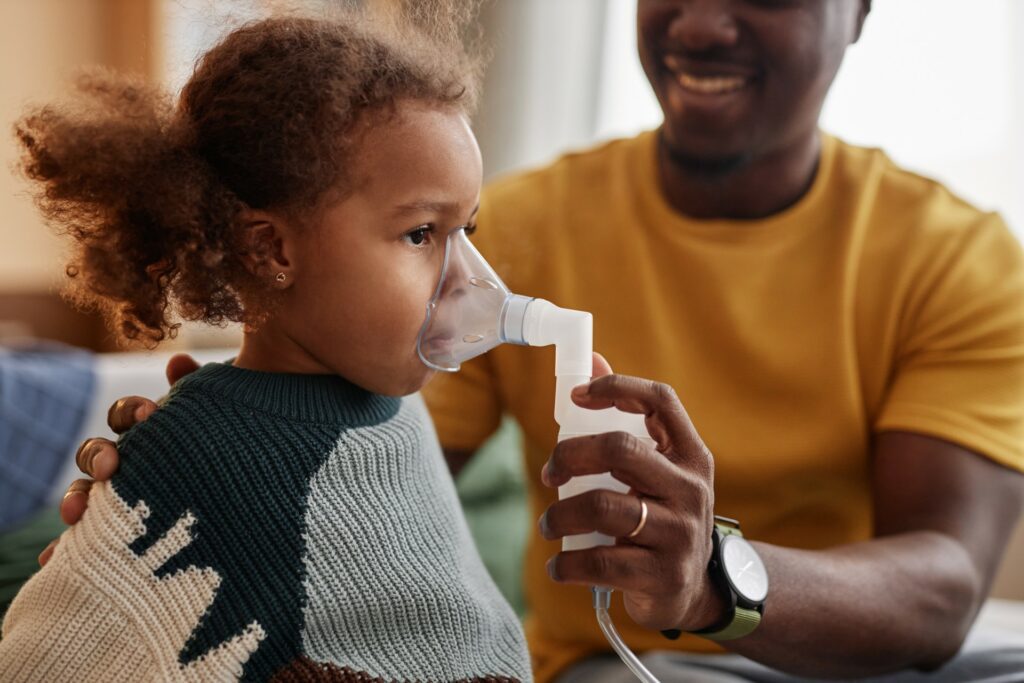Asthma is a chronic condition that affects millions of children worldwide. It can be frightening for both children and parents, but understanding the condition, its triggers, and how to manage symptoms can make a significant difference. In this blog post, we will explore what asthma is, its causes, common symptoms, and practical tips for managing asthma at home.
What is Asthma?
Asthma is a respiratory condition that causes inflammation and narrowing of the airways, making it difficult for air to flow in and out of the lungs. This results in symptoms such as wheezing, coughing, shortness of breath, and chest tightness. Asthma can be triggered by various factors, including allergens, exercise, and respiratory infections.
For children, asthma can affect daily activities, including school and play. It’s crucial for parents to understand how to care for a child with asthma and ensure they lead a healthy, active life despite the condition.
What Causes Childhood Asthma?
While the exact cause of childhood asthma remains unclear, several factors contribute to its development. Some common triggers include:
- Genetics: A family history of asthma or allergies increases the likelihood of a child developing asthma.
- Environmental Factors: Exposure to allergens like pollen, mold, dust mites, pet dander, and tobacco smoke can lead to the exacerbation of asthma symptoms.
- Respiratory Infections: Viral infections, particularly in infancy, can affect lung development and increase the risk of asthma.
- Air Pollution: Living in areas with high levels of pollution can contribute to respiratory issues.
Understanding what causes childhood asthma can help parents mitigate these risks and create a safer environment for their children.
Common Symptoms of Asthma in Children
Recognizing childhood asthma symptoms is key to effective management. Some common symptoms include:
- Wheezing: A high-pitched whistling sound when exhaling.
- Coughing: Frequent coughing, especially at night or during exercise.
- Shortness of Breath: Difficulty breathing or feeling out of breath during physical activities.
- Chest Tightness: A feeling of pressure or tightness in the chest.
If you notice these symptoms in your child, it’s essential to consult with a pediatrician for a
proper diagnosis and treatment plan.
Tips for Managing Asthma Symptoms at Home
Managing asthma symptoms effectively requires a proactive approach. Here are some practical tips for parents:
Develop an Asthma Attack Plan
Work with your pediatrician to create an asthma action plan that outlines what to do during an asthma attack. This plan should include:
- Daily Management: Medications and how to take them.
- Recognizing Symptoms: Early signs of worsening asthma.
- Emergency Contacts: Information for when to seek immediate help.
Monitor Asthma Triggers
Identifying and avoiding triggers is crucial for managing childhood asthma. Common triggers include:
- Allergens: Pollen, dust mites, mold, and pet dander.
- Irritants: Tobacco smoke, strong odors, and air pollution.
- Weather Changes: Cold air or changes in weather can also trigger symptoms.
Keeping a journal of your child’s symptoms can help identify patterns and triggers.
Use Asthma Medications Correctly
Ensure your child takes asthma medications as prescribed. There are two main types of asthma medications:
- Quick-relief Medications: These are used to treat acute symptoms and provide fast relief during an asthma attack.
- Long-term Control Medications: These are taken daily to prevent symptoms and reduce inflammation.
Educate your child about their medications and the importance of adhering to their treatment plan.
Supporting Your Child’s Well-Being
Supporting a child with asthma goes beyond medication. Here are additional ways to promote their overall well-being:
Encourage Regular Exercise
Regular physical activity can help strengthen your child’s lungs and improve overall health. However, be mindful of their asthma triggers. Encourage activities like swimming, which is often easier on the lungs.
Recognizing Early Signs of an Asthma Flare-Up
Teaching your child to recognize early signs of an asthma flare-up is essential. This includes symptoms like increased coughing or wheezing. Early intervention can prevent a full-blown asthma attack.
Help Your Child Stay Calm During an Attack
Asthma attacks can be frightening. Teach your child relaxation techniques, such as deep breathing or visualization, to help them stay calm during an attack. Being calm can help ease their symptoms and make it easier for them to breathe.
When to Seek Medical Help
Knowing when to seek medical help is crucial in managing childhood asthma.
Signs You Should Contact Your Pediatrician
Contact your pediatrician if you notice:
- Increased frequency of symptoms.
- Symptoms that do not respond to medication.
- Changes in your child’s ability to participate in daily activities.
Emergency Situations
Seek immediate medical attention if your child exhibits any of the following:
- Severe difficulty breathing.
- Blue lips or face.
- Extreme fatigue or confusion.
In such situations, having an emergency plan in place is vital.
Childhood Asthma Support from COPA
COPA offers valuable resources and support for families dealing with childhood asthma. We provide education on managing asthma, access to medical professionals, and community resources. Regular visits at COPA can empower families and improve the quality of life for children with asthma.
Caring for a child with asthma involves understanding the condition, recognizing symptoms, and implementing effective management strategies. By developing an asthma action plan, monitoring triggers, and using medications correctly, parents can help their children lead healthy and active lives. Additionally, support from organizations like COPA can provide families with the resources they need. With the right approach, asthma does not have to limit your child’s potential or happiness.
